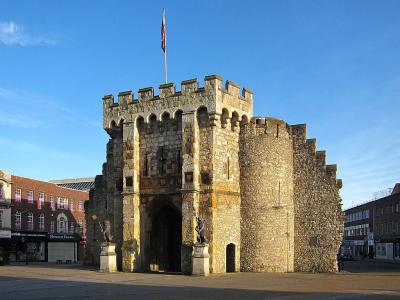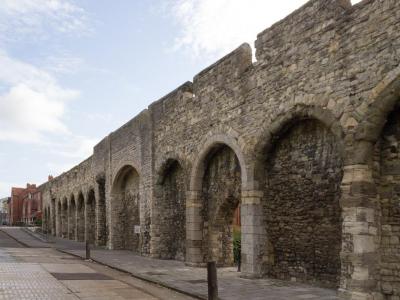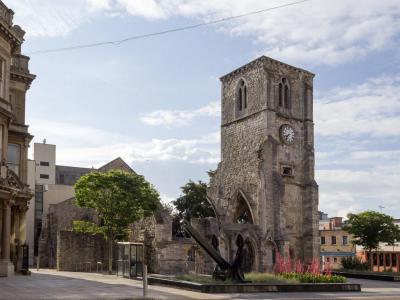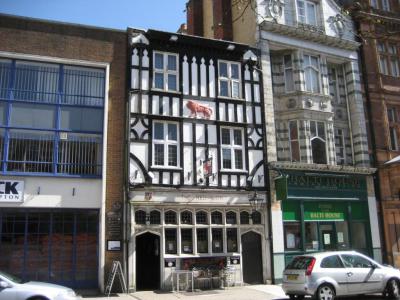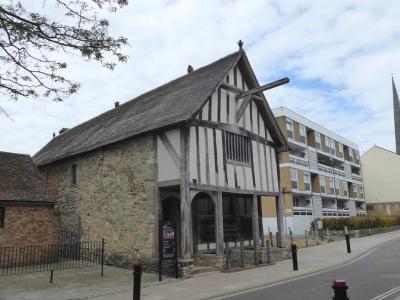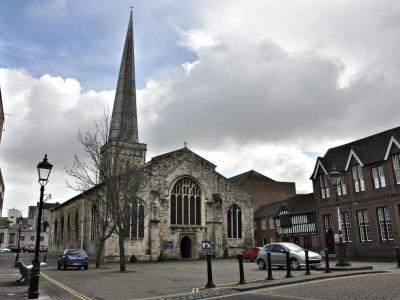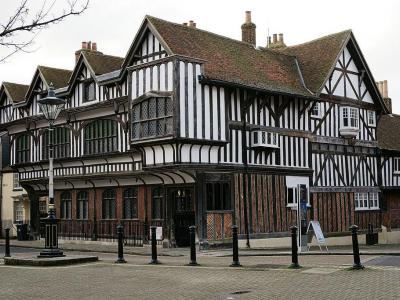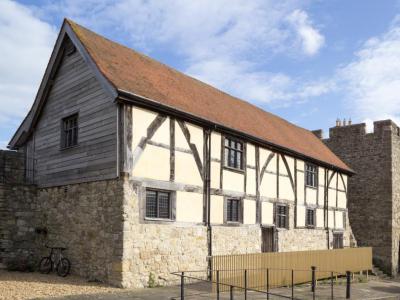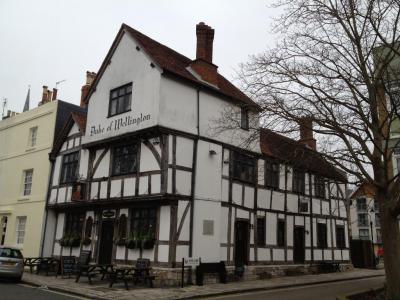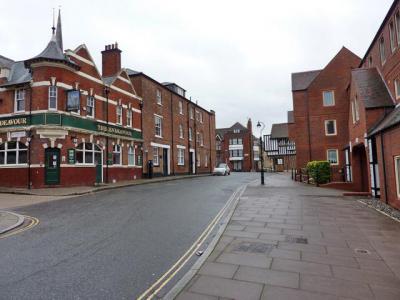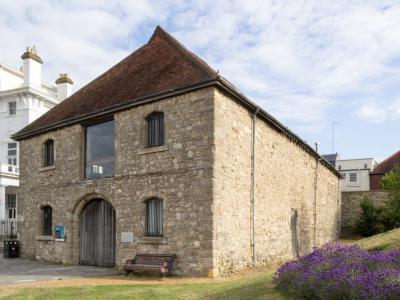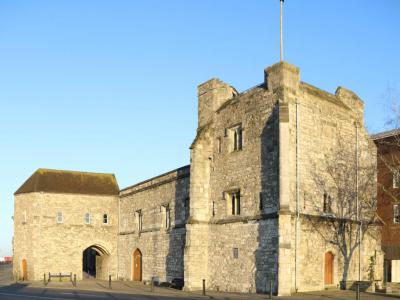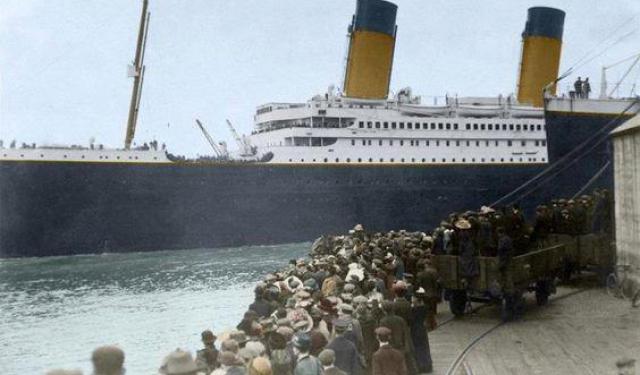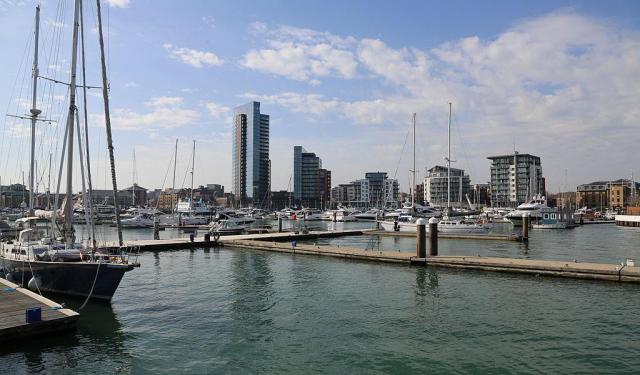Southampton Old Town Walking Tour (Self Guided), Southampton
Southampton is a bustling coastal city with the history going back all the way to the Stone Age. There are over 90 listed buildings and 30 ancient monuments in the Old Town, including medieval watch towers and dungeons, an array of churches, fine timber-framed Tudor houses, inns and hole-in-the-wall pubs. Despite heavy bombardment during WWII, much of Southampton's historic heritage survived the blasts, owing to which today visitors can experience what life was like back in the day by taking a lovely stroll down the cobbled streets of the old quarter.
The best place to start this journey is the Bargate (formerly the main gate of the city) – possibly Southampton’s most iconic structure, built around 1180. And of course, walking some of England’s best-preserved medieval Town Wall, nearly half of which still stands since the 15th century, is a must for any guest of Southampton. Among other places to visit, equally informative about Southampton’s past, are:
Red Lion Inn – a historic, half-timbered pub built at the turn of the 16th century;
Medieval Merchant's House – a restored property of a prosperous merchant, John Fortin; built circa 1290;
St. Michael's Church – Southampton's oldest church still in use; founded in 1070;
Tudor House and Garden – a former 15th-century property offering atmospheric insight into the lives of its residents over the years, plus a chance to witness something altogether paranormal, being one of city’s most haunted locations;
God's House Tower – a late 13th-century gatehouse.
If you genuinely love history and want to step back in time to see what Southampton’s Old Town has to offer, take this self-guided walk.
The best place to start this journey is the Bargate (formerly the main gate of the city) – possibly Southampton’s most iconic structure, built around 1180. And of course, walking some of England’s best-preserved medieval Town Wall, nearly half of which still stands since the 15th century, is a must for any guest of Southampton. Among other places to visit, equally informative about Southampton’s past, are:
Red Lion Inn – a historic, half-timbered pub built at the turn of the 16th century;
Medieval Merchant's House – a restored property of a prosperous merchant, John Fortin; built circa 1290;
St. Michael's Church – Southampton's oldest church still in use; founded in 1070;
Tudor House and Garden – a former 15th-century property offering atmospheric insight into the lives of its residents over the years, plus a chance to witness something altogether paranormal, being one of city’s most haunted locations;
God's House Tower – a late 13th-century gatehouse.
If you genuinely love history and want to step back in time to see what Southampton’s Old Town has to offer, take this self-guided walk.
How it works: Download the app "GPSmyCity: Walks in 1K+ Cities" from Apple App Store or Google Play Store to your mobile phone or tablet. The app turns your mobile device into a personal tour guide and its built-in GPS navigation functions guide you from one tour stop to next. The app works offline, so no data plan is needed when traveling abroad.
Southampton Old Town Walking Tour Map
Guide Name: Southampton Old Town Walking Tour
Guide Location: England » Southampton (See other walking tours in Southampton)
Guide Type: Self-guided Walking Tour (Sightseeing)
# of Attractions: 12
Tour Duration: 2 Hour(s)
Travel Distance: 1.9 Km or 1.2 Miles
Author: Maia
Sight(s) Featured in This Guide:
Guide Location: England » Southampton (See other walking tours in Southampton)
Guide Type: Self-guided Walking Tour (Sightseeing)
# of Attractions: 12
Tour Duration: 2 Hour(s)
Travel Distance: 1.9 Km or 1.2 Miles
Author: Maia
Sight(s) Featured in This Guide:
- Bargate
- Southampton Town Wall
- Holyrood Church
- Red Lion Inn
- Medieval Merchant's House
- St. Michael's Church
- Tudor House Museum & Garden
- Tudor Merchant's Hall
- Duke of Wellington Pub
- Bugle Street
- Wool House
- God's House Tower
1) Bargate
Bargate is an impressive medieval gatehouse that was built around 1180. Located in the center of High Street, Bargate was the traditional entrance and main gateway to Southampton. Bargate is praised as the finest and most complex gateway in England.
Bargate was built with flint and stone. In 1280, builders added imposing drum towers on the north side. Then, in the early 1400s, the north front was added.
At some point during the 1400s, Southampton began using Bargate as a prison. Then, during the 16th century, Southampton's court leet started meeting in the Bargate.
The Bargate was used as Southhampton's guildhall and market for centuries. Visitors can still see the vaults where merchants stored wine.
The fabled lion sculptures were added during the 16th century. The lions are thought to symbolize the legend of Sir Bevois, who founded Southhampton. Sir Bevios is the subject of many heroic legends, including a legend that tells of Sir Bevois slaying two lions to protect a princess. The lions were restored in 2020.
Visitors will find 11 heraldic shields on the Bargate's north side. Unfortunately, the original shields decayed with time, and many attempts have been made to restore them.
In 1899, 1914, and 1923, council members debated demolishing Bargate to accommodate increasing road traffic. Instead, the town council decided to separate Bargate from the town walls.
During WWII, Bargate was used as an air-raid shelter.
Bargate was built with flint and stone. In 1280, builders added imposing drum towers on the north side. Then, in the early 1400s, the north front was added.
At some point during the 1400s, Southampton began using Bargate as a prison. Then, during the 16th century, Southampton's court leet started meeting in the Bargate.
The Bargate was used as Southhampton's guildhall and market for centuries. Visitors can still see the vaults where merchants stored wine.
The fabled lion sculptures were added during the 16th century. The lions are thought to symbolize the legend of Sir Bevois, who founded Southhampton. Sir Bevios is the subject of many heroic legends, including a legend that tells of Sir Bevois slaying two lions to protect a princess. The lions were restored in 2020.
Visitors will find 11 heraldic shields on the Bargate's north side. Unfortunately, the original shields decayed with time, and many attempts have been made to restore them.
In 1899, 1914, and 1923, council members debated demolishing Bargate to accommodate increasing road traffic. Instead, the town council decided to separate Bargate from the town walls.
During WWII, Bargate was used as an air-raid shelter.
2) Southampton Town Wall (must see)
Southampton has had some defensive structures since occupied by the Romans. French forces attacked Southampton in 1338. However, the defenses were not adequate.
Work on the new wall began in the 1360s. Eventually, the wall was 1.25 miles long and wholly enclosed Southampton. The impressive wall housed 29 towers and eight gates. The towers were built to house cannons, which was a new technology in the 1300s.
The walls were used for defense throughout the 15th century. By the 18th century, the walls and gatehouses fell into disrepair. More recently, efforts have been made to preserve these historic walls.
Today, about half of the length of the original walls is still visible. Only 13 of the original 29 towers and six of the original gates still stand. God's House Tower still stands and is one of the first urban buildings to be purpose-built to hold gunpowder weapons. God's House Tower is three stories high and is next to God's House Gate.
Arundel tower still stands and is a popular attraction. The west walls are home to a unique feature called The Arcades. They are a series of arches built in the 14th century to reinforce the original 12th and 13th-century walls.
Work on the new wall began in the 1360s. Eventually, the wall was 1.25 miles long and wholly enclosed Southampton. The impressive wall housed 29 towers and eight gates. The towers were built to house cannons, which was a new technology in the 1300s.
The walls were used for defense throughout the 15th century. By the 18th century, the walls and gatehouses fell into disrepair. More recently, efforts have been made to preserve these historic walls.
Today, about half of the length of the original walls is still visible. Only 13 of the original 29 towers and six of the original gates still stand. God's House Tower still stands and is one of the first urban buildings to be purpose-built to hold gunpowder weapons. God's House Tower is three stories high and is next to God's House Gate.
Arundel tower still stands and is a popular attraction. The west walls are home to a unique feature called The Arcades. They are a series of arches built in the 14th century to reinforce the original 12th and 13th-century walls.
3) Holyrood Church
Holyrood Church, originally one of the five churches serving the old walled town of Southampton, dates back to 1320. Though heavily damaged by Nazi bombing during the Blitz in November 1940, its remnants remain a poignant memorial to the sailors of the Merchant Navy, officially dedicated in 1957.
The church's history stretches back even further, with the first documentary evidence dating from 1160 when Henry II granted it, along with other chapels, to the monks of Saint Denys. Its name, "Holy Rood," hints at Saxon origins.
Following the destruction during World War II, only the tower in the southwest corner, the eastern chancel, and significant portions of the north walls remain intact. The church's wooden spire and grand west window were lost, and much of the central structure was destroyed. On the west face of the surviving tower, a plaque honors Charles Dibdin, a Southampton-born poet, dramatist, and composer famed for his sea songs like "Tom Bowling" and "Poor Jack." Above this plaque are the clock and bells, which feature pre-1760 Quarter Jacks-small figures that strike each quarter-hour.
Inside the church, a memorial fountain, erected in 1912–1913 under the tower, pays tribute to those who perished in the sinking of the RMS Titanic. The fountain rests on four stone columns, with carvings of the Titanic adorning a curved pediment, all beneath a four-columned cupola.
Holyrood Church, though a shell of its former self, stands as a moving testament to both its ancient past and more recent history.
The church's history stretches back even further, with the first documentary evidence dating from 1160 when Henry II granted it, along with other chapels, to the monks of Saint Denys. Its name, "Holy Rood," hints at Saxon origins.
Following the destruction during World War II, only the tower in the southwest corner, the eastern chancel, and significant portions of the north walls remain intact. The church's wooden spire and grand west window were lost, and much of the central structure was destroyed. On the west face of the surviving tower, a plaque honors Charles Dibdin, a Southampton-born poet, dramatist, and composer famed for his sea songs like "Tom Bowling" and "Poor Jack." Above this plaque are the clock and bells, which feature pre-1760 Quarter Jacks-small figures that strike each quarter-hour.
Inside the church, a memorial fountain, erected in 1912–1913 under the tower, pays tribute to those who perished in the sinking of the RMS Titanic. The fountain rests on four stone columns, with carvings of the Titanic adorning a curved pediment, all beneath a four-columned cupola.
Holyrood Church, though a shell of its former self, stands as a moving testament to both its ancient past and more recent history.
4) Red Lion Inn
The Red Lion Inn in Southampton is a Grade II* listed pub with a rich history, dating back to the late 15th or early 16th century. Located on the High Street, within the old walled town below the Bargate, the inn is considered one of the oldest in the city. Its half-timbered design and historic interiors have earned it a spot on the Campaign for Real Ale's National Inventory of Historic Pub Interiors.
One of the inn’s most notable features is the room known as the "Court Room." Legend has it that this was the site of the trial of the conspirators involved in the infamous Southampton Plot of 1415, a plot to assassinate King Henry V before his departure to the Battle of Agincourt. However, this is widely considered to be local lore, as historical evidence suggests the trial occurred 75 years before the inn's construction. Despite this, the room is still a point of fascination for visitors, with its rich Tudor-style timbering and historic atmosphere.
The inn is also said to be haunted. Ghostly sightings, including a spectral barmaid visible only from the knees up, have been reported by patrons. Additionally, a mournful procession of ghosts allegedly linked to the plotters has been seen leaving the inn.
Adding to the inn’s allure is its Norman-era cellar, which dates back to the 12th century, and its connection to notable historical figures. During his exile in the mid-19th century, Juan Manuel de Rosas, former governor of Buenos Aires, frequented the Red Lion.
The Red Lion’s long history and intriguing legends make it a must-visit for those interested in Southampton’s past, as well as anyone curious about England’s historic pub culture.
One of the inn’s most notable features is the room known as the "Court Room." Legend has it that this was the site of the trial of the conspirators involved in the infamous Southampton Plot of 1415, a plot to assassinate King Henry V before his departure to the Battle of Agincourt. However, this is widely considered to be local lore, as historical evidence suggests the trial occurred 75 years before the inn's construction. Despite this, the room is still a point of fascination for visitors, with its rich Tudor-style timbering and historic atmosphere.
The inn is also said to be haunted. Ghostly sightings, including a spectral barmaid visible only from the knees up, have been reported by patrons. Additionally, a mournful procession of ghosts allegedly linked to the plotters has been seen leaving the inn.
Adding to the inn’s allure is its Norman-era cellar, which dates back to the 12th century, and its connection to notable historical figures. During his exile in the mid-19th century, Juan Manuel de Rosas, former governor of Buenos Aires, frequented the Red Lion.
The Red Lion’s long history and intriguing legends make it a must-visit for those interested in Southampton’s past, as well as anyone curious about England’s historic pub culture.
5) Medieval Merchant's House
The Medieval Merchant's House in Southampton is a carefully restored late 13th-century building that stands as a testament to the city’s medieval past. Built around 1290 by John Fortin, a prosperous merchant, the house has remained largely intact despite centuries of use. It gained architectural significance after sustaining damage during the German bombing in 1940, which revealed the medieval interior, leading to its restoration in the 1980s by English Heritage.
The house is built following a traditional medieval right-angle, narrow plan design, with a functional undercroft used for wine storage, ensuring a constant temperature. The upper floor features a projecting bedchamber, a common medieval practice to increase space. Notably, historian Glyn Coppack highlights the building as "the only building of its type to survive substantially as first built," marking it as a Grade I listed building and a scheduled monument.
Facing French Street, the house showcases a mix of Bembridge and Purbeck stone walls and a timber frontage. The ground floor includes a reconstructed medieval shop front, a central hall with a 14th-century Flemish chimney, and an inner private room. The hallways, though traditional, reflect a medieval design challenge of poor lighting. The undercroft, originally designed to store barrels of wine, features an 18th-century brick floor.
The first floor houses two chambers, with the eastern one projecting into the street-similar to medieval homes found in Shrewsbury, Tewkesbury, and York. Marks from the original builders can still be seen on the timbers of this room. The western chamber retains elements of its 19th-century modifications, including a Victorian-era ceiling. The roof has been reconstructed with Cornish slate, mimicking the original medieval design.
Today, the Medieval Merchant's House serves as a fascinating glimpse into medieval life, managed by English Heritage as a tourist attraction.
The house is built following a traditional medieval right-angle, narrow plan design, with a functional undercroft used for wine storage, ensuring a constant temperature. The upper floor features a projecting bedchamber, a common medieval practice to increase space. Notably, historian Glyn Coppack highlights the building as "the only building of its type to survive substantially as first built," marking it as a Grade I listed building and a scheduled monument.
Facing French Street, the house showcases a mix of Bembridge and Purbeck stone walls and a timber frontage. The ground floor includes a reconstructed medieval shop front, a central hall with a 14th-century Flemish chimney, and an inner private room. The hallways, though traditional, reflect a medieval design challenge of poor lighting. The undercroft, originally designed to store barrels of wine, features an 18th-century brick floor.
The first floor houses two chambers, with the eastern one projecting into the street-similar to medieval homes found in Shrewsbury, Tewkesbury, and York. Marks from the original builders can still be seen on the timbers of this room. The western chamber retains elements of its 19th-century modifications, including a Victorian-era ceiling. The roof has been reconstructed with Cornish slate, mimicking the original medieval design.
Today, the Medieval Merchant's House serves as a fascinating glimpse into medieval life, managed by English Heritage as a tourist attraction.
6) St. Michael's Church
This impressive church is Southampton's oldest building still in use. Saint Michael's Chruch was founded in 1070. Henry II gave the church to the monks of Saint Denys, who administered the church until the 1537 Dissolution.
Saint Michael's was enlarged during the 13th century as Southampton prospered. The first spire was added in the 15th century and renovated with an additional 9 feet in 1887. The spire is now 165 feet high.
While much of Southhampton was damaged during WWII, the church and spire escaped significant damage.
The East Window depicts Southampton's five medieval churches. Unfortunately, Saint Michael's is the only one still standing. The West Window portrays Saint Michael killing the dragon.
The unique font dates to the 12th century and was created from a single block of black marble.
One of the brass lecterns was rescued from Holyrood Church. This pulpit dates to the 14th or 15th century and is the most impressive in England. It depicts an eagle with separated wing feathers.
Saint Michael's church is home to several tombs. The most famous tomb belongs to Sir Richard Lyster, who was the chief justice of the King's Bench. He was interred here in 1554.
Saint Michael's was enlarged during the 13th century as Southampton prospered. The first spire was added in the 15th century and renovated with an additional 9 feet in 1887. The spire is now 165 feet high.
While much of Southhampton was damaged during WWII, the church and spire escaped significant damage.
The East Window depicts Southampton's five medieval churches. Unfortunately, Saint Michael's is the only one still standing. The West Window portrays Saint Michael killing the dragon.
The unique font dates to the 12th century and was created from a single block of black marble.
One of the brass lecterns was rescued from Holyrood Church. This pulpit dates to the 14th or 15th century and is the most impressive in England. It depicts an eagle with separated wing feathers.
Saint Michael's church is home to several tombs. The most famous tomb belongs to Sir Richard Lyster, who was the chief justice of the King's Bench. He was interred here in 1554.
7) Tudor House Museum & Garden (must see)
Tudor House shows visitors what life in Southampton was like during Tudor times. Tudor House is one of Southampton's most important buildings and brings 800 years of history to life.
Instead of simply viewing objects in glass cases, the museum immerses visitors in history with beautiful presentations and interactive displays.
Visitors will start with an interactive presentation. Spirits from the past tell you about Tudor House and give you glimpses into its history.
The museum has many displays of artifacts from ancient history to the present. Visitors can admire a medieval jewel casket, Victorian stuffed birds, a pair of shoes from the 1920s. One of the more intriguing displays hosts glass panes painted with bird depictions.
The Book of Hours is one of the museum's most precious items. This very small book is very fragile and dates to around 1480. The Book of Hours is a hand-illustrated prayer book written in Flemish with Latin flourishes.
The sedan chair was a popular way for wealthy people to travel around town. A mid-18th-century sedan chair for hire is on display.
The penny-farthing bicycle is another popular item. This bicycle features one very large wheel and one very small wheel and was popular in the late 19th century.
Kids and adults alike will be amazed by the Tudor dollhouses, complete with opening doors and windows and small figures. Various displays recreate daily life in Tudor times. Visitors can see a historic kitchen and learn about food prep.
The gardens are beautiful and include ancient canons. The gardens have been planned to represent a garden from the 1500s and include formal pathways and low-cut hedges. On the way out of the museum and gardens, you can visit the small attic.
Why You Should Visit:
Tudor House dates back to 1348 when a wealthy merchant owned it. Different families have owned the house throughout the centuries, and today's visitors can enjoy a complete immersion into Southampton's history.
Tips:
The Tudor House Cafe serves fabulous cream teas and gives visitors a gorgeous view of the gardens.
Instead of simply viewing objects in glass cases, the museum immerses visitors in history with beautiful presentations and interactive displays.
Visitors will start with an interactive presentation. Spirits from the past tell you about Tudor House and give you glimpses into its history.
The museum has many displays of artifacts from ancient history to the present. Visitors can admire a medieval jewel casket, Victorian stuffed birds, a pair of shoes from the 1920s. One of the more intriguing displays hosts glass panes painted with bird depictions.
The Book of Hours is one of the museum's most precious items. This very small book is very fragile and dates to around 1480. The Book of Hours is a hand-illustrated prayer book written in Flemish with Latin flourishes.
The sedan chair was a popular way for wealthy people to travel around town. A mid-18th-century sedan chair for hire is on display.
The penny-farthing bicycle is another popular item. This bicycle features one very large wheel and one very small wheel and was popular in the late 19th century.
Kids and adults alike will be amazed by the Tudor dollhouses, complete with opening doors and windows and small figures. Various displays recreate daily life in Tudor times. Visitors can see a historic kitchen and learn about food prep.
The gardens are beautiful and include ancient canons. The gardens have been planned to represent a garden from the 1500s and include formal pathways and low-cut hedges. On the way out of the museum and gardens, you can visit the small attic.
Why You Should Visit:
Tudor House dates back to 1348 when a wealthy merchant owned it. Different families have owned the house throughout the centuries, and today's visitors can enjoy a complete immersion into Southampton's history.
Tips:
The Tudor House Cafe serves fabulous cream teas and gives visitors a gorgeous view of the gardens.
8) Tudor Merchant's Hall
The Tudor Merchant's Hall, now known as Westgate Hall, is a hidden gem nestled within Southampton's medieval old town walls. Originally built before 1428 in Saint Michael’s Square, the hall served as a bustling hub for trade, with its upper floors functioning as a cloth hall and its open arcaded ground floor as the town's fish market. By the 17th century, the building had fallen into disrepair and was sold in 1634 to Alderman Edward Exton, who dismantled it and relocated it to its current position near the West Gate. The ground floor arcade was subsequently walled up, converting the space into a warehouse.
In the 1970s, Westgate Hall underwent significant restoration, transforming it into a picturesque venue with vaulted ceilings and exposed timber beams that add to its charm. Now a Grade II* listed building, it serves as a versatile event space for weddings, receptions, concerts, and public gatherings. The hall offers a first-floor ceremony room with seating for up to 74 guests, making it a popular choice for special occasions.
With a storied past that includes rumored use as a guardroom or garrison, Westgate Hall holds a significant place in Southampton’s history. Its location near the waterfront and cruise terminals provides convenient access to local hotels and restaurants, making it an attractive venue for celebrations. After its restoration, the hall was renamed Westgate Hall in 2010, continuing its legacy as a beautiful and historic site for public use.
In the 1970s, Westgate Hall underwent significant restoration, transforming it into a picturesque venue with vaulted ceilings and exposed timber beams that add to its charm. Now a Grade II* listed building, it serves as a versatile event space for weddings, receptions, concerts, and public gatherings. The hall offers a first-floor ceremony room with seating for up to 74 guests, making it a popular choice for special occasions.
With a storied past that includes rumored use as a guardroom or garrison, Westgate Hall holds a significant place in Southampton’s history. Its location near the waterfront and cruise terminals provides convenient access to local hotels and restaurants, making it an attractive venue for celebrations. After its restoration, the hall was renamed Westgate Hall in 2010, continuing its legacy as a beautiful and historic site for public use.
9) Duke of Wellington Pub
The Duke of Wellington is a classic British pub. It serves real English ales in a historic building that seeps ambiance and authenticity.
The building is located on Bugle Street, one of the oldest and most historically relevant parts of town. The building was built in 1220 on top of Normal cellars and vaults. The first resident was Benedict Ace, one of the town's first mayors.
It wasn't until 1494 that the building became a public house. It was bought by Holland-born brewer Rowland Johnson, who called it Brew House. Then, of course, he started brewing his own ales and thusly began the city's first brewery.
In the 1600s, the pilgrims would have passed this pub on their way to board the Mayflower.
The pub has changed names several times over the years. It was first the Brew House, and then it became the Shipwrights Arms in honor of the many shipbuilders who patronized it. Finally, in 1815 it was named for the Duke of Wellington in honor of his victory in the Battle of Waterloo.
The Duke of Wellington is still a pub today. They have function rooms for rent and serve locally-made ales. It's an excellent place for some pub-grub, too. The burgers are well-regarded.
The building is located on Bugle Street, one of the oldest and most historically relevant parts of town. The building was built in 1220 on top of Normal cellars and vaults. The first resident was Benedict Ace, one of the town's first mayors.
It wasn't until 1494 that the building became a public house. It was bought by Holland-born brewer Rowland Johnson, who called it Brew House. Then, of course, he started brewing his own ales and thusly began the city's first brewery.
In the 1600s, the pilgrims would have passed this pub on their way to board the Mayflower.
The pub has changed names several times over the years. It was first the Brew House, and then it became the Shipwrights Arms in honor of the many shipbuilders who patronized it. Finally, in 1815 it was named for the Duke of Wellington in honor of his victory in the Battle of Waterloo.
The Duke of Wellington is still a pub today. They have function rooms for rent and serve locally-made ales. It's an excellent place for some pub-grub, too. The burgers are well-regarded.
10) Bugle Street
Bugle Street's name comes from the Latin word "Buculus," or young bull. It is sometimes called Bull Street, but it also refers to the bugle-horn, made initially from young bulls' horns.
The street runs from Saint Michaels Square to the Town Quay. Upper Bugle Street was historically made up of Fish Street and Pepper Alley, connecting north from Saint Michaels Square to Simnel Street.
The street was one of the original laid out within the city's stone medieval walls. Today it is still lined with many historic and beautiful buildings.
Notable sights along the road include the Royal Southern Yacht Club on the south end. The building stands on the corner of Bugle and the pier. It was opened in 1846 and designed by architect Thomas Sandon Hack. The magnificent building centers around a state and ballroom. There was even an 11-gun battery for signaling the starts of races or for celebrating birthdays.
Other attractions along Bugle Street include the must-see Tudor House and the Duke of Wellington Pub.
Most of the other homes and businesses along the route were built between the 16th and 18th centuries. It has been said that Bugle Street is the best historic street in Southampton.
The street runs from Saint Michaels Square to the Town Quay. Upper Bugle Street was historically made up of Fish Street and Pepper Alley, connecting north from Saint Michaels Square to Simnel Street.
The street was one of the original laid out within the city's stone medieval walls. Today it is still lined with many historic and beautiful buildings.
Notable sights along the road include the Royal Southern Yacht Club on the south end. The building stands on the corner of Bugle and the pier. It was opened in 1846 and designed by architect Thomas Sandon Hack. The magnificent building centers around a state and ballroom. There was even an 11-gun battery for signaling the starts of races or for celebrating birthdays.
Other attractions along Bugle Street include the must-see Tudor House and the Duke of Wellington Pub.
Most of the other homes and businesses along the route were built between the 16th and 18th centuries. It has been said that Bugle Street is the best historic street in Southampton.
11) Wool House
The Wool House, located in Southampton, is a medieval building with a rich history dating back to the late 14th century. Originally constructed to store wool for export to Italy, it played a vital role in the wool trade, which was a key factor in Southampton’s prosperity during the Middle Ages. Wool was shipped from this site to Venice and Genoa in galleys and carracks, symbolizing the city’s thriving maritime economy.
In the early 19th century, the Wool House took on a new role, serving as a prison for French prisoners of war during the Napoleonic Wars. Some of these prisoners even carved their names into the wooden beams, leaving a lasting mark of their presence.
During the early 20th century, the building was occupied by The Moonbeam Engineering Company Limited, which produced motor launches and marine equipment. Edwin Moon, a pioneer of aviation, used a section of the Wool House to design and construct an aircraft, which he successfully flew from what would later become Southampton International Airport in 1910.
In 1966, after being restored by Southampton City Corporation, the Wool House became home to the Southampton Maritime Museum. The museum documented the city’s maritime heritage, including its connection to ocean liners and the RMS Titanic, and remained there until 2012 when it moved to the SeaCity Museum.
In 2013, Element Arts transformed the Wool House into a temporary gallery and arts venue, hosting a variety of live events, workshops, and exhibitions. However, in 2015, the Wool House was given new life once again, reopening as a brewpub and restaurant under the Dancing Man Brewery, blending its historical significance with modern culinary and brewing culture.
The Wool House is a Grade I listed building, and a plaque on its wall honors its centuries-old history, from its origins in the wool trade to its role as a community space today.
In the early 19th century, the Wool House took on a new role, serving as a prison for French prisoners of war during the Napoleonic Wars. Some of these prisoners even carved their names into the wooden beams, leaving a lasting mark of their presence.
During the early 20th century, the building was occupied by The Moonbeam Engineering Company Limited, which produced motor launches and marine equipment. Edwin Moon, a pioneer of aviation, used a section of the Wool House to design and construct an aircraft, which he successfully flew from what would later become Southampton International Airport in 1910.
In 1966, after being restored by Southampton City Corporation, the Wool House became home to the Southampton Maritime Museum. The museum documented the city’s maritime heritage, including its connection to ocean liners and the RMS Titanic, and remained there until 2012 when it moved to the SeaCity Museum.
In 2013, Element Arts transformed the Wool House into a temporary gallery and arts venue, hosting a variety of live events, workshops, and exhibitions. However, in 2015, the Wool House was given new life once again, reopening as a brewpub and restaurant under the Dancing Man Brewery, blending its historical significance with modern culinary and brewing culture.
The Wool House is a Grade I listed building, and a plaque on its wall honors its centuries-old history, from its origins in the wool trade to its role as a community space today.
12) God's House Tower
God's House Tower, located at the southeast corner of Southampton's town walls, is a historic 13th-century gatehouse that once provided access to the town from the Platform and Town Quay. Originally known as Saltmarsh Gate due to its proximity to marshlands, it later became known as God's House Gate because of its location near God's House Hospital, founded in 1168 to provide refuge for travelers.
Over the centuries, the tower evolved from a simple gatehouse to a significant fortification. Following a French raid in 1338, the town's defenses were strengthened, and in 1417, a two-story gallery and three-story tower were added, designed specifically to support cannon fire. This tower, equipped with eight gunports and rooftop firing points, helped the town gunner protect the sluices controlling seawater flow into a tidal moat that powered a nearby water mill.
In the following centuries, as Southampton's need for strong defenses diminished, God's House Tower transitioned into various roles, from a house of correction in the 1700s to the town jail by 1786. By 1855, a new prison was built elsewhere, and the tower fell into disuse until it was repurposed for storage in 1876. The building's exterior was cleaned and restored during this time, though part also served as a mortuary.
In 1961, God's House Tower became the Museum of Archaeology, showcasing Southampton's history, but closed in 2011 with exhibits moved to SeaCity Museum. Reopened in 2019 as an arts and heritage venue, it now features galleries, panoramic rooftop views, and a Hoxton Bakery branch. The Grade I listed building, known for its stone rubble construction, retains historical features like portcullis grooves, cinquefoil windows, and keyhole gunports, alongside traces of its tidal sluices and mural stairway.
Over the centuries, the tower evolved from a simple gatehouse to a significant fortification. Following a French raid in 1338, the town's defenses were strengthened, and in 1417, a two-story gallery and three-story tower were added, designed specifically to support cannon fire. This tower, equipped with eight gunports and rooftop firing points, helped the town gunner protect the sluices controlling seawater flow into a tidal moat that powered a nearby water mill.
In the following centuries, as Southampton's need for strong defenses diminished, God's House Tower transitioned into various roles, from a house of correction in the 1700s to the town jail by 1786. By 1855, a new prison was built elsewhere, and the tower fell into disuse until it was repurposed for storage in 1876. The building's exterior was cleaned and restored during this time, though part also served as a mortuary.
In 1961, God's House Tower became the Museum of Archaeology, showcasing Southampton's history, but closed in 2011 with exhibits moved to SeaCity Museum. Reopened in 2019 as an arts and heritage venue, it now features galleries, panoramic rooftop views, and a Hoxton Bakery branch. The Grade I listed building, known for its stone rubble construction, retains historical features like portcullis grooves, cinquefoil windows, and keyhole gunports, alongside traces of its tidal sluices and mural stairway.
Walking Tours in Southampton, England
Create Your Own Walk in Southampton
Creating your own self-guided walk in Southampton is easy and fun. Choose the city attractions that you want to see and a walk route map will be created just for you. You can even set your hotel as the start point of the walk.
Titanic Tour in Southampton
Over a hundred years since the sinking of Titanic, the echo of that tragedy still reverberates throughout Southampton. Indeed, nowhere else was the pain of the Titanic disaster, one of the deadliest in maritime history, felt more intensely than here. The majority of Titanic's 900-strong crew were from Southampton, of whom only a handful returned home. More than 500 local households overnight... view more
Tour Duration: 2 Hour(s)
Travel Distance: 3.9 Km or 2.4 Miles
Tour Duration: 2 Hour(s)
Travel Distance: 3.9 Km or 2.4 Miles
Southampton Waterfront Walk
A major seaport on the south coast of England, the city of Southampton abounds in attractions of various sorts. Southampton Waterfront, in particular, holds significant historical and cultural value, offering ample opportunities for sightseeing, shopping, dining, recreation, and entertainment.
At the heart of this vibrant area is the Pilgrims Fathers Memorial, commemorating the departure of... view more
Tour Duration: 1 Hour(s)
Travel Distance: 2.1 Km or 1.3 Miles
At the heart of this vibrant area is the Pilgrims Fathers Memorial, commemorating the departure of... view more
Tour Duration: 1 Hour(s)
Travel Distance: 2.1 Km or 1.3 Miles
Southampton Introduction Walking Tour
Southampton is an important port city with a long history. Archaeological records indicate that the area has been settled since the Stone Age. The Romans had a settlement here, and the Anglo-Saxons later settled in the area.
Southampton became a major port after the 1066 Norman Conquest. Southampton's impressive walls were built following a French incursion in the 1300s.
The Mayflower... view more
Tour Duration: 2 Hour(s)
Travel Distance: 3.3 Km or 2.1 Miles
Southampton became a major port after the 1066 Norman Conquest. Southampton's impressive walls were built following a French incursion in the 1300s.
The Mayflower... view more
Tour Duration: 2 Hour(s)
Travel Distance: 3.3 Km or 2.1 Miles
The Most Popular Cities
/ view all



